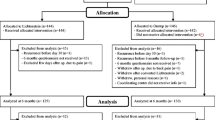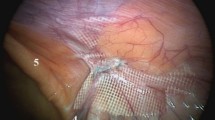Abstract
Background
The incidence of chronic pain after endoscopic hernia repair varies between 1 and 16 %. Studies regarding the course of pain in time after the operation are scarce.
Methods
473 male patients ≥18 years of age, scheduled for totally extraperitoneal (TEP) hernia repair (Prolene® mesh) between March 2010 and August 2012 were requested to record pain symptoms preoperative, and 1 day, 1 week, 6 weeks, 3 months and 1 year postoperatively and visit the outpatient department 3 months and 1 year postoperatively for a standardized interview and physical examination.
Results
Preoperatively, 25 % (n = 114) of the patients had moderate-to-severe pain (NRS 4–10). Six weeks postoperatively, 3 % (n = 12) of the patients still experienced moderate-to-severe pain. Three months after TEP, only 3 patients (0.6 %) had moderate-to-severe pain, while 83 patients (18 %) experienced mild pain. One year after TEP, 39 patients experienced mild pain (8 %) and 3 patients moderate pain (0.7 %), no patients experienced severe pain after 1 year. Patients with moderate-to-severe pain preoperatively had a higher risk of pain persisting until 3 months and 1 year postoperatively (p = 0.03). In most patients who had pain 3 months postoperatively and were pain-free 1 year after TEP, pain ‘faded out’ at 4–6 months postoperatively. Two patients had a not-painful recurrent hernia, diagnosed 2 and 5 months after TEP repair.
Conclusion
Moderate-to-severe pain after TEP hernia repair is self-limiting, with less than 1 % of the patients reporting moderate pain 1 year postoperatively.


Similar content being viewed by others
References
Kehlet H (2008) Chronic pain after groin hernia repair. Br J Surg 95:135–136
Poobalan AS, Bruce J, King PM, Chambers WA, Krukowski ZH, Smith WC (2001) Chronic pain and quality of life following open inguinal hernia repair. Br J Surg 88:1122–1126
Eklund A, Montgomery A, Bergkvist L, Rudberg C, For the Swedish Multicentre Trial of Inguinal Hernia Repair by Laparoscopy (SMIL) study group (2010) Chronic pain 5 years after randomized comparison of laparoscopic and Lichtenstein inguinal hernia repair. Br J Surg 97:600–608
Bay-Nielsen M, Perkins FM, Kehlet H (2001) Pain and functional impairment 1 year after inguinal herniorrhaphy: a nationwide questionnaire study. Ann Surg 233:1–7
Hindmarch AC, Cheong E, Lewis MPN et al (2003) Attendance at a pain clinic with severe chronic pain after open and laparoscopic inguinal hernia repairs. Br J Surg 90:1152–1154
Simons MP, Aufenacker T, Bay-Nielsen M, Bouillot JL, Campanelli G, Conze J, de Lange D, Fortelny R, Heikkinen T, Kingsnorth A, Kukleta J, Morales-Conde S, Nordin P, Schumpelick V, Smedberg S, Smietanski M, Weber G, Miserez M (2009) European Hernia Society guidelines on the treatment of inguinal hernia in adult patients. Hernia 13:343–403
Classification of chronic pain (1986) Description of chronic pain syndromes and definitions of pain terms. Prepared by the International Association for the study of pain Subcommittee on taxonomy. Pain Suppl 3:S1–S226
Aasvang E, Kehlet H (2005) Chronic postoperative pain: the case of inguinal herniorrhaphy. Br J Anaesth 95:69–76
Kehlet H, Roumen RM, Reinpold W, Miserez M (2013) Invited commentary: persistent pain after inguinal hernia repair: what do we know and what do we need to know? Hernia 17(3):293–297
Poelman M, van den Heuvel B, Deelder J et al (2013) EAES Consensus Development Conference on endoscopic repair of groin hernias. Surg Endosc 27:3505-19
Langeveld HR, van ‘t Riet M, Weidema WF, Stassen LPS, Steyerberg EW, Lange J, J HJ, Jeekel HR (2010) Total extraperitoneal inguinal hernia repair compared with lichtenstein (the LEVEL-trial): a randomized controlled trial. Ann Surg 251(5):819–824
Koch CA, Greenlee SM, Larson DR et al (2006) Randomized prospective study of totally extraperitoneal inguinal hernia repair: fixation versus no fixation of mesh. JSLS 10:457–460
Fränneby U, Gunnarsson U, Andersson M, Heuman R, Nordin P, Nyrén O, Sandblom G (2008) Validation of an Inguinal Pain Questionnaire for assessment of chronic pain after groin hernia repair. Br J Surg 95:488–493
Loos MJA, Houterman S, Scheltinga MRM, Roumen RMH (2008) Evaluating postherniorrhaphy groin pain: visual analogue or verbal rating scale? Hernia 12:147–151
Aasvang E, Mohl B, Bay-Nielsen M, Kehlet H (2006) Pain related sexual dysfunction after inguinal herniorrhaphy. Pain 122:258–263
Ali SM, Zendejas B, Yadav S, Hernandez-Irizarry RC, Lohse CM, Farley DR (2013) Predictors of chronic groin discomfort after laparoscopic totally extraperitoneal inguinal hernia repair. J Am Coll Surg 217(1):72–78
Lau H, Patil G, Yuen WK, Lee F (2003) Prevalence and severity of chronic pain after endoscopic totally extraperitoneal inguinal hernioplasty. Surg Endosc 17:1620–1623
Chowbey PK, Garg N, Sharma A, Khullar R, Soni V, Baijal M, Mittal T (2010) Prospective randomized clinical trial comparing lightweight mesh and heavyweight polypropylene mesh in endoscopic totally extraperitoneal groin hernia repair. Surg Endosc 24:3073–3079
Hanswijck de Jonge van P, Lloyd A, Horsfall L (2008) The measurement of chronic pain and health-related quality of life following inguinal hernia repair: a review of the literature. Hernia 12:561–569
Leibl BJ, Bittner R, Kraft B, Schwarz J (2011) One year results of a prospective, randomized clinical trial comparing four meshes in laparoscopic inguinal hernia repair (TAPP). Hernia 15:503–510
Van der Pool AEM, Harlaar JJ, den Hoed PT, Weidema WF, Van Veen RN (2010) Long-term follow-up evaluation of chronic pain after endoscopic total extraperitoneal repair of primary and recurrent inguinal hernia. Surg Endosc 24:1707–1711
Aasvang E, Bay-Nielsen M, Kehlet H (2006) Pain and functional impairment 6 years after inguinal herniorrhaphy. Hernia 10:316–332
Singh AN, Bansal VK, Misra MC, Kumar S, Rajeshwari S, Kumar A, Sagar R, Kumar A (2012) Testicular functions, chronic pain, and quality of life after laparoscopic and open mesh repair of inguinal hernia: a prospective randomized controlled trial. Surg Endosc 26:1304–1317
Amid PK (2004) Causes, prevention, and surgical treatment of postherniorrhaphy neuropathic inguinodynia: triple neurectomy with proximal end implantation. Hernia 8:343–349
Alfieri S, Amid PK, Campanelli G, Izard G, Kehlet H, Wijsmuller AR, Di Micelli D, Doglietto GB (2011) International guidelines for prevention and management of post-operative chronic pain following inguinal hernia surgery. Hernia 15:239–249
Ducic I, Dellon AL (2004) Testicular pain after inguinal hernia repair: an approach to resection of the genital branch of genitofemoral nerve. J Am Coll Surg 198(2):181–184
Amid PK, Hiatt JR (2007) New understanding of the causes and surgical treatment of postherniorrhaphy inguinodynia and orchalgia. J Am Coll Surg 205(2):381–385
Colby F (1953) Essential urology. In: Jesse FT (ed) Embryology, anatomy and physiology of the testis and epididymis. Williams & Wilkins, Baltimore, pp 101–103
Kim FJ, Pinto P, Ming SuL, Jarrett TW, Rattner LE, Montgomery R, Kavoussi L (2003) Ipsilateral orchialgia after laparoscopic donor nephrectomy. J Endourol 17(6):405–409
Conflict of interest
The authors certify that they have no commercial associations (e.g. consultancies, stock ownership, equity interests, patent-licensing arrangements, etc.) that might pose a conflict of interest in connection with the submitted article. Partial funding in support of the manuscript was provided in the form of a Research grant from Johnson & Johnson, as is acknowledged in the “Financial Disclosure” attachment.
Author information
Authors and Affiliations
Corresponding author
Rights and permissions
About this article
Cite this article
Burgmans, J.P.J., Schouten, N., Clevers, G.J. et al. Pain after totally extraperitoneal (TEP) hernia repair might fade out within a year. Hernia 19, 579–585 (2015). https://doi.org/10.1007/s10029-015-1384-3
Received:
Accepted:
Published:
Issue Date:
DOI: https://doi.org/10.1007/s10029-015-1384-3




